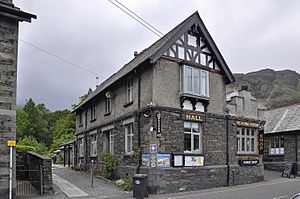Ruskin Museum facts for kids
 |
|
| Established | 31 August 1901 |
|---|---|
The Ruskin Museum is a cool little museum in a town called Coniston, in a beautiful part of northern England called Cumbria. It's a great place to learn about the history of the Lake District and the famous Coniston Water.
It was started way back in 1901 by a man named W. G. Collingwood. He was an artist and a historian who used to work for a famous art critic named John Ruskin. The museum was created to remember John Ruskin and also to tell the stories of the local area.
The museum is run by a special group called "The Coniston Institute and Ruskin Museum," which is a registered charity. This means they work to help the community and don't make money for themselves.
What You Can See at the Museum

The Ruskin Museum has lots of interesting things to explore! You can learn about the old copper and slate mines in the region, discover local geology (how rocks and land are formed), and see how people used to make lace and farm in the area. There's also a section about the writer Arthur Ransome, who wrote the "Swallows and Amazons" books.
A big part of the museum is dedicated to the life and work of John Ruskin, the famous art critic.
Outside the museum, you'll find "Riverdale," a collection of over sixty tiny buildings. These miniature houses, bridges, and farm buildings were all handmade by a local builder named John Usher. They show what local buildings look like, but in a super small size!
The Story of Bluebird
One of the most exciting parts of the museum is the special collection about Donald Campbell. He was a brave man who tried to break the water speed record on Coniston Water in his special boat, Bluebird K7. Sadly, he passed away during one of these attempts.
The museum now has the restored Bluebird boat itself! A new building was even made just for Bluebird and an exhibition about its story. This new wing was finished in 2010.
On December 7, 2006, Donald Campbell's daughter, Gina Campbell, officially gave Bluebird to the Ruskin Museum. The boat had been recovered from Coniston Water around 2001. Gina wanted to make sure Bluebird would be safe for everyone in Coniston and around the world to see. A man named Bill Smith offered to help restore the boat for free.
After many years of restoration, Bluebird finally returned to Coniston on March 9, 2024. It had been away for over 23 years! An agreement was reached to make sure Bluebird would be housed in the special wing at the Ruskin Museum.
Since its return, more than 6,000 people have visited the museum to see Bluebird in just one month! The museum even has plans to run Bluebird on Coniston Water again in 2026, which would be amazing to see.
Museum Improvements
The Ruskin Museum has grown and improved a lot over the years. In the 1980s, people realized the museum needed help to keep going for a long time. A big project was started, and with help from different groups, £850,000 was raised to make the museum even better.
The improved museum, with its new extension, opened to the public in May 1999. It was officially opened by a government minister in May 2000.
More recently, in 2017 and 2018, an architect named Takeshi Hayatsu worked with students to design and build a cool kiosk next to the museum. This kiosk has copper tiles decorated by local people and shares information about the area's copper mining history. There's also a community bread oven in the museum grounds, which was another project by Hayatsu and students!
See also

